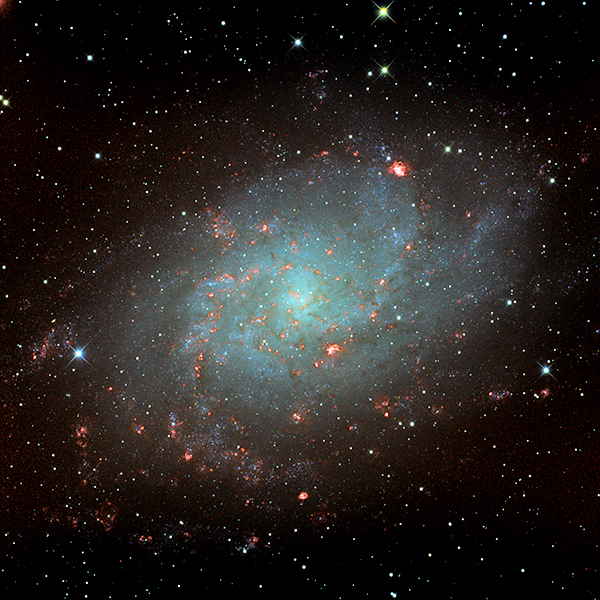In my first post about the Triangulum Galaxy (M33), I mentioned that there were many star formation regions visible in the galaxy. I also pointed out the largest known such region, NGC 604, which is in that galaxy neighbor.
These star formation regions are called HII regions because they are made up primarily of ionized hydrogen gas. (HII is a reference to that ionized hydrogen. Astronomers refer to neutral hydrogen as HI and molecular hydrogen as H2.) You’ll find some images that highlight these regions below, and I’ll also say more about these regions and their nature. See my previous post for more information as well. If you just want pretty pictures (and who doesn’t want pretty pictures?), please visit this page for larger versions than included below.
Ionized Hydrogen and H-alpha Emissions
Because they are made up of ionized gas, these clouds glow. Stelar radiation strips the hydrogen atoms of their single electron, but the free electrons also seek to recombine with the bare protons. When they do so, they first form atoms with a fair amount of excess energy. As the atoms settle down into lower energy states, they emit radiation. When an electron settles down the last jump to its lowest energy state, it emits a photon of a specific energy, and thus with a specific wavelength of light. This light is a narrow line in the spectrum which is called H-alpha by astronomers, and is a deep red color. Filters can be used to isolate this particular light in a telescope, enabling one to see only the light generated by this particular atomic energy dance. Thus, one can very easily see these HII regions against the general background of stelar and other radiation. H-alpha is an important wavelength that astronomers use to study objects in space and can help us better understand the dynamics of a astronomical system.
M33 in H-alpha

This image is the galaxy M33 in H-alpha. As you can see, much of the galaxy fades away. Instead, we most prominently see the patches of light from the HII regions. The very large HII region called NGC 604 really stands out in the upper right quadrant. (An illustration of it’s location, with a Hubble Telescope image of the area, can be found here.) But you can also fairly easily trace the major spiral arms in this image. These stallar formation regions concentrate in the galactic disk, and then very often along the arms of a spiral galaxy. Thus the arms of a spiral galaxy are revealed to be largely defined by regions of fairly recent, and ongoing, stelar formation. Spiral galaxies are also among the younger galaxies we see. The older galaxies tend to be elliptical galaxies without arms and with a relatively featureless profile. They typically have very few HII regions and little stelar formation going on. The molecular clouds from which stars may form have generally been dissipated or used up by the time galaxies reach that stage in their evolution. This makes some sense if the galactic arms are intimately connected with stelar formation processes.
In order to see these regions better in the context of the galaxy seen in the broader visible light spectrum, I have created the image below. The H-alpha image has been combined as bright red areas which stand out against the spiral arms and dust lanes of M33.

The Life Cycle of an HII Region
HII regions begin life as large and very cold molecular clouds, consisting mostly of hydrogen in molecular form. Something trigers areas of the cloud to collapse and form a star. (There are a variety of mechanisms that are believed to be possible causes.) Not every star will produce the glowing emission nebulas we see in H-alpha above. It takes a fair amount of energy to ionize the hydrogen. Many stars just don’t have what it takes. At the heart of an HII region, there will be a young and very massive star. Only these massive stars, many of them at least 15 times as massive as our sun, produce enough ultraviolet radiation to ionize the nearby gas. These stars burn very hot and very quickly, but are often obscured by the cloud they are embedded in. The ionized region falls within a sphere around the star, the size of which depends on the density of the cloud and the amount of ultraviolet radiation it produces. The hotter, brighter, and more massive the star, the more UV radiation. The denser the cloud, the smaller the region, because the quota of atoms that can be ionized is more quickly reached.
These emission nebulas are also fairly short lived. As the young star burns, radiation and solar winds will blow away the leftover gasses of the cloud in which it formed. The nebula will glow only when there is sufficient gas within the sphere of ionizing radiation from the star. When the gas cloud is dissipated by stellar radiation (or the star has drifted out of the cloud), the HII region will no longer continue to be ionized, revert to HI, and go dark. These nebula will only last a few million years. The longest lasting of the stars that fuel their ionization will only burn normally for perhaps 10-20 million years. The most massive of these stars may even go supernova after just a couple of million years.
Very often, the large, bright stars that give birth to an HII region’s ionization will also form in groups. Large HII regions form when the spheres created by each individual star overlap in space. There must be some large groups of these bright stars in some regions of M33, given the size of some of the HII regions seen there.
Larger version of the images here, as well as my recent standard color version, and instrument and exposure information can be seen at this page. Also see my astrophotography gallery for other astrophotographs.
Leave a Reply